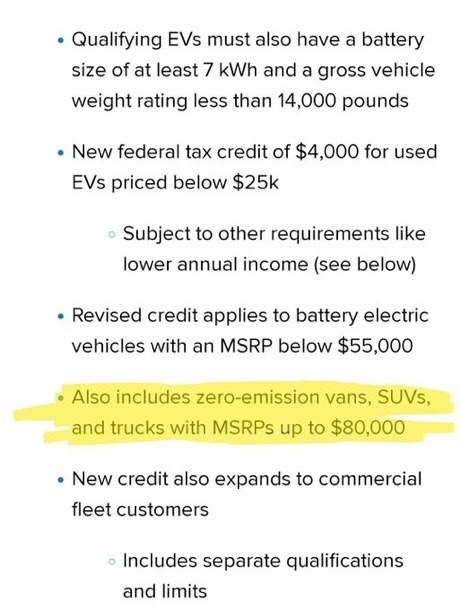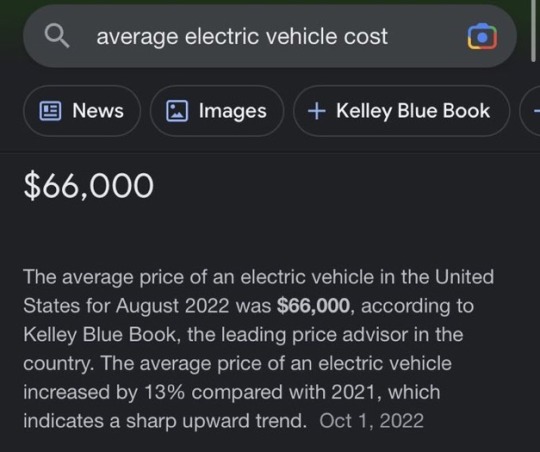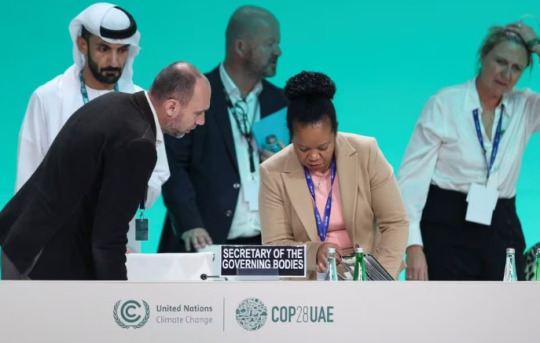#zero carbon emission
Text
Computational Modeling Aspect of Fuel Cells: A Continuous Powerhouse
Fuel cells are called continuous powerhouses because it is a device that does not store energy but runs continuously to produce electricity as long as the fuel is provided. The byproduct of the fuel cell is water, hence the “clean energy” or “zero carbon emission” technology.
#fuel cell#fluid dynamics#continuous powerhouses#zero carbon emission#clean energy#Anode and cathode reactions for PEMFC#Polymer Electrolyte Membrane Fuel Cell (PEMFC)#Direct Methanol Fuel Cells (DMFC)#Alkaline Fuel Cells (AFC)#Phosphoric Acid Fuel Cells (PAFC)#energy#Electricity generation
0 notes
Text

Does the HumVEE qualify for the tax credit?


Nope it absolutely does not.
“Great American road trip is going to be electric”
It’s gunna be a long trip, and it costs about 70-90 bucks worth of electricity to fully charge its battery.

Can an average income individual afford the cost of an electric vehicle?


God. No.
#cars#electric cars#zero emissions#climate solutions#climate change#carbon emissions#automotive#joe biden#eco friendly
462 notes
·
View notes
Text
#good news#science#environmentalism#bacteria#microbiology#carbon offset#carbon sequestration#carbon sinks#carbon emissions#sustainable farming#agriculture#greenhouse gas reduction#carbon zero#environment#nature#climate change#climate crisis
16 notes
·
View notes
Text
Carbon dioxide removal is not a current climate solution — we need to change the narrative
35 notes
·
View notes
Text
the thing of it is if we all just individually liked or disliked taylor swift, it would be normal, but as it stands there are people who are obsessively reverent (and defensive) over everything about her and those people are insane and insufferable and wrong. and there are people who hate her vehemently and refuse to entertain the idea of any value (or even acknowledge talent) in anything she makes and those people are generally not insane but they're also kind of insufferable and observably wrong. everybody needs to stop talking about this woman online until we can figure out whats going on
#txt#i hate swiftie-swifties as much as the next guy and yes this new album title is annoying but ouh my god#with the new tracklist drop (and also with midnights lyric leaks) people who hate her will be so vitriolic over#completely inoffensive lyrics and song titles that you wouldnt bat an eye at from like any other pop icon. I logically understand why#if her stuff's not for you and you dislike her as a person (i also think shes evil ftr) itll drive you to madness seeing the idol worship#but good god give it a rest like your hating is worthless when yr going after everything she does including the stuff that clearly works#energy better spent when you zero in on the truly indefensible stuff like 'i come back stronger than a 90s trend' or idk the carbon emission#s#theres no point to this but i just scrolled through a bunch of tags of circlejerk ridiculing the ts11 tracklist and it read like a group of#middle schoolers making fun of someone they dont like by just listing traits about them. like omg her shirt is ridiculous >a normal shirt#>they all nod about how the shirt is ridiculous and makes this girl uniquely cringe and they ignore the 40 other kids in the cafeteria weari#ng the exact same shirt#like guys. you are all SO ANNOYING.
2 notes
·
View notes
Text
COP28 countries reach landmark deal to “transition” away from fossil fuels
The COP28 climate talks in Dubai have culminated in a historic agreement that will see the world phase out all fossil fuels for the first time.
The president of this year’s UN-organised summit, Sultan Al Jaber of the UAE, brokered an agreement that was strong enough for the US and the EU on the need to sharply curb the use of fossil fuels while keeping Saudi Arabia and other oil producers on board.
The final agreement calls for countries to phase out fossil fuels from their energy systems in a swift and orderly fashion, which helped convince sceptics. The agreement also calls for countries to contribute to the global transition effort – rather than explicitly forcing the transition on their own.
The so-called “UAE Consensus” ends the hottest year on record, which led to droughts and devastating wildfires. Al Jaber, who’s also chief executive officer of Abu Dhabi National Oil Co, noted:
“Together we have confronted the realities and sent the world in the right direction.”
Read more HERE

#world news#world politics#news#current events#cop28#cop28 climate summit#cop28climateconference#climate catastrophe#climate emergency#fossil fuels#global warming#climate change#cop 28#net zero#climate crisis#climate action#climate emissions#emissions reduction#carbon emissions#co2 emissions#greenhouse gas emissions#fossil fighters#oil and gas#crude oil#natural gas
2 notes
·
View notes
Link
#candice gaukel andrews#carbon takeback obligation#clean air act#clean energy#clean water act#climate change#divestment#earth day#earth day 2023#environment#environmental protection agency#fossil fuels#founder of earth day#global warming#ipcc#natural habitat adventures#nathab#nature#nature lovers#net-zero emissions#outrider foundation#paris climate agreement#science#science and environment#scientific research#senator gaylord nelson#solar power#tia nelson#wind power#world wildlife fund
5 notes
·
View notes
Text
Conflicted about cost-benefit analysis of international conferences
Last week I wrote about my stimulating experience of attending a conference in Orlando, Florida and presenting our recent research to the experimental mechanics community for the first time in four years. Whilst there, I was conscious of the ecological footprint of my trip – the venue was making extensive use of single use plastics on a scale that surprised me. However, my trans-Atlantic flight…

View On WordPress
#aerospace#carbon emissions#carbon footprint#Engineering#MyResearch#Orlando#research#sustainability#zero carbon
2 notes
·
View notes
Text
#zero emissions#carbon emissions#reduce carbon emissions#carbon neutral#please sign and share#petition#petitions#please sign this petition#please share#please sign#climate action#climate science#climate activism#go green
2 notes
·
View notes
Text
Worth a listen, it covers a lot of ground and was quite interesting- who knew hazelnuts are actually climate negative? I didn't! It also addresses whether it is better to ship more carbon neutral foods long distance or to eat local emissions-heavy foods, which I know there is a deal of confusion about.
The carbon savings we've made so far have been the easy ones. To reach Net Zero, we need to start changing the way we live and work. We need to rethink our homes, our heating, our transportation and our food. We can’t reach net zero without these changes impacting on each and every one of us.
In this series, comedian and environmental economist Matt Winning looks at the ways in which unique aspects of British culture have shaped how we generate carbon, how we've managed to reduce emissions, and the challenges we now face to eliminate them completely. Travelling around Britain - from terraced houses to the tiniest of crofts, and from golf courses to cement factories – Matt reveals how our energy consumption is bound up with who we are.
#food systems#agriculture#food#carbon emissions#net zero#climate change#food waste#it's based in britian yes but the larger lessons are applicable beyond those shores#ahaha i forgot it was recorded when liz truss was in office#that dates it rather precisely doesn't it
9 notes
·
View notes
Text
“William wants to focus on energy efficient housing projects rather than traditionally-designed ones in the Duchy of Cornwall”

#construction is one of the world's largest producers of carbon#reducing emissions is impossible without looking at housing first#building net zero homes and especially remodeling homes to be net zero is very very expensive#but I'm glad to see baldy addresing this#hopefully looking into it with earthshot as well#ily baldy#william#ju rambles#architecture and the environment are my two passions what can I say
4 notes
·
View notes
Link
Excerpt from this story from EcoWatch:
In their bid to reach net-zero by a certain date, many companies are buying carbon offsets to compensate for their greenhouse gas emissions by funding activities that are supposed to remove an equivalent amount of carbon dioxide from the atmosphere.
But UK climate advisory group the Climate Change Committee issued a report Thursday warning that the current offset system is doing more harm than good when it comes to the overall reduction of greenhouse gas emissions.
“Businesses want to do the right thing and it’s heartening to see so many firms aiming for early Net Zero dates,” Climate Change Committee Chief Executive Chris Stark said in a press release announcing the report. ‘But poor-quality offsets are crowding out high-integrity ones. Businesses face confusion over the right approach to take.”
Carbon offsetting is a process whereby a company will buy a carbon credit by funding a project that removes carbon dioxide from the atmosphere in some way. The credit will then count against the purchaser’s actual emissions when they calculate their net climate impact.
This mechanism has become hugely popular as more companies make net-zero emissions pledges, and the voluntary carbon market (VCM) tripled in value between 2020 and 2021 to reach $2 billion.
However, there is a flaw in this strategy. For one thing, it can make it too easy for companies to simply purchase carbon credits and spend less effort on reducing their emissions. This is exacerbated by the fact that carbon credits can be as cheap as less than $4 tonne of carbon removed, as Reuters noted.
Another problem is that not all credits purchased are of equal value or actually remove the carbon they say they will.
“The evidence reviewed for this report suggests that VCMs are not currently supporting Net Zero globally: low prices and inaccurate claims mean that credits may not be meaningfully reducing emissions, while their use may cause buyers to take less action on their own emissions impact,” the report authors wrote.
5 notes
·
View notes
Text
#we shall see#science#cars#automobiles#electric cars#zero emissions#carbon zero#canada#climate change#carbon reduction#carbon emissions#net zero
9 notes
·
View notes
Text
The lower house of the Indian parliament Monday passed a bill establishing a central scheme for the purchase and sale of carbon credits. The bill also promotes clean energy by obligating certain large consumers of electricity to use renewable energy and conserve energy.
The Energy Conservation (Amendment) Act seeks to amend the two-decade-old Energy Conservation Act and introduce a carbon credit trading scheme. A carbon credit is a permit that allows the holder the “right” to emit one ton of carbon dioxide or the equivalent amount of another greenhouse gas (GHG) by offsetting it against the reduction of equivalent emissions. The emission reductions may either be “certified” and sold through a third-party regulator, such as the Clean Development Mechanism by the UN Framework Convention on Climate Change (UNFCCC), or “voluntary” and exchanged between buyers and sellers directly.
Under the carbon credit trading scheme proposed in the bill, registered entities will be issued carbon credit certificates which they can sell to other entities or individuals. The scheme incorporates the offset markets in energy efficiency and renewable energy that currently operate in India. While India has previously engaged in the global carbon credit market—with the city of Indore exporting UNFCCC-approved carbon credits for about $62,000 in 2020—the carbon credit certificates proposed in the bill can only be issued by the Indian government or agencies it authorizes. The Power Minister also reportedly stated the scheme would be wholly domestic. Source jurist.org
#carbon credits#greenhouse gases#kyoto protocol#carbon permits#pollution#products#rocket launch#climate change#carbon emissions#climate control#global#government#global warming#net zero#natural resources#national debt#project 1#solar energy
7 notes
·
View notes
Text
#esg trends#decarbonization#Green Builder Media#building codes#building professionals#operational carbon#embodied carbon#global greenhouse gas#Zero Emissions
2 notes
·
View notes
Text
How to Plan Your Sustainable House Move
Planning a house move can consume many resources and leave an increased carbon footprint behind. If you are looking at reducing your impact on the world around you, a house move might seem like you are undoing all of the work you have put in so far to live more sustainably. While you might not be able to achieve a zero-emission house move, you can move sustainably to reduce this impact.

Use eco-friendly packaging materials.
You can do several things to reduce the number of packaging materials you will need for a house move especially when you re trying to make it sustainable. Ensure that you purchase your products with recyclable packaging, and if that is not an option, try to reduce the number of packaging materials you use. For example, try to use paper wrap instead of cling film and cardboard boxes instead of plastic.
Another great alternative to plastic wrap is to use a reusable cloth bag for food storage instead and for protecting fragile items.
**********
Read More at https://tinyurl.com/3bat825j
*********
After you have finished with your donated items, you should try to recycle as much as possible. This helps reduce the amount of waste produced and can be disposed of at the end of its lifecycle will further leads to a sustainable house move. Recycling also helps reduce the number of carbon emissions caused by the processing and transportation of materials.
#move house#moving#packing#ecofriendly#footprint#alternative#packaging#zero emissions#recycling#carbon footprint#moverspackers#real estate#movers
2 notes
·
View notes